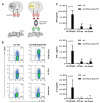Development and Functional Characterization of a Versatile Radio-/Immunotheranostic Tool for Prostate Cancer Management
- PMID: 35454902
- PMCID: PMC9027777
- DOI: 10.3390/cancers14081996
Development and Functional Characterization of a Versatile Radio-/Immunotheranostic Tool for Prostate Cancer Management
Abstract
Due to its overexpression on the surface of prostate cancer (PCa) cells, the prostate stem cell antigen (PSCA) is a potential target for PCa diagnosis and therapy. Here we describe the development and functional characterization of a novel IgG4-based anti-PSCA antibody (Ab) derivative (anti-PSCA IgG4-TM) that is conjugated with the chelator DOTAGA. The anti-PSCA IgG4-TM represents a multimodal immunotheranostic compound that can be used (i) as a target module (TM) for UniCAR T cell-based immunotherapy, (ii) for diagnostic positron emission tomography (PET) imaging, and (iii) targeted alpha therapy. Cross-linkage of UniCAR T cells and PSCA-positive tumor cells via the anti-PSCA IgG4-TM results in efficient tumor cell lysis both in vitro and in vivo. After radiolabeling with 64Cu2+, the anti-PSCA IgG4-TM was successfully applied for high contrast PET imaging. In a PCa mouse model, it showed specific accumulation in PSCA-expressing tumors, while no uptake in other organs was observed. Additionally, the DOTAGA-conjugated anti-PSCA IgG4-TM was radiolabeled with 225Ac3+ and applied for targeted alpha therapy. A single injection of the 225Ac-labeled anti-PSCA IgG4-TM was able to significantly control tumor growth in experimental mice. Overall, the novel anti-PSCA IgG4-TM represents an attractive first member of a novel group of radio-/immunotheranostics that allows diagnostic imaging, endoradiotherapy, and CAR T cell immunotherapy.
Keywords: (18)F-JK-PSMA-7; Ac-225; CAR T cell; Cu-64; IgG4; PSCA; PSMA; prostate cancer; theranostics.
Conflict of interest statement
The authors declare that there is no conflict of interest.
Figures










Similar articles
-
Extended half-life target module for sustainable UniCAR T-cell treatment of STn-expressing cancers.J Exp Clin Cancer Res. 2020 May 5;39(1):77. doi: 10.1186/s13046-020-01572-4. J Exp Clin Cancer Res. 2020. PMID: 32370811 Free PMC article.
-
More advantages in detecting bone and soft tissue metastases from prostate cancer using 18F-PSMA PET/CT.Hell J Nucl Med. 2019 Jan-Apr;22(1):6-9. doi: 10.1967/s002449910952. Epub 2019 Mar 7. Hell J Nucl Med. 2019. PMID: 30843003
-
Immunotheranostic target modules for imaging and navigation of UniCAR T-cells to strike FAP-expressing cells and the tumor microenvironment.J Exp Clin Cancer Res. 2023 Dec 15;42(1):341. doi: 10.1186/s13046-023-02912-w. J Exp Clin Cancer Res. 2023. PMID: 38102692 Free PMC article.
-
124I-Anti-PSCA 2B3 minibody.2009 Mar 25 [updated 2009 May 13]. In: Molecular Imaging and Contrast Agent Database (MICAD) [Internet]. Bethesda (MD): National Center for Biotechnology Information (US); 2004–2013. 2009 Mar 25 [updated 2009 May 13]. In: Molecular Imaging and Contrast Agent Database (MICAD) [Internet]. Bethesda (MD): National Center for Biotechnology Information (US); 2004–2013. PMID: 20641706 Free Books & Documents. Review.
-
124I-Anti–prostate stem-cell antigen back-mutated 2B3 diabody.2010 May 25 [updated 2010 Aug 1]. In: Molecular Imaging and Contrast Agent Database (MICAD) [Internet]. Bethesda (MD): National Center for Biotechnology Information (US); 2004–2013. 2010 May 25 [updated 2010 Aug 1]. In: Molecular Imaging and Contrast Agent Database (MICAD) [Internet]. Bethesda (MD): National Center for Biotechnology Information (US); 2004–2013. PMID: 20681082 Free Books & Documents. Review.
Cited by
-
Significance of PSCA as a novel prognostic marker and therapeutic target for cancer.Cancer Cell Int. 2024 Apr 16;24(1):135. doi: 10.1186/s12935-024-03320-6. Cancer Cell Int. 2024. PMID: 38627732 Free PMC article. Review.
-
Implementing Ac-225 labelled radiopharmaceuticals: practical considerations and (pre-)clinical perspectives.EJNMMI Radiopharm Chem. 2024 Feb 6;9(1):9. doi: 10.1186/s41181-024-00239-1. EJNMMI Radiopharm Chem. 2024. PMID: 38319526 Free PMC article. Review.
-
Specific and safe targeting of glioblastoma using switchable and logic-gated RevCAR T cells.Front Immunol. 2023 Apr 14;14:1166169. doi: 10.3389/fimmu.2023.1166169. eCollection 2023. Front Immunol. 2023. PMID: 37122703 Free PMC article.
-
Tumor buster - where will the CAR-T cell therapy 'missile' go?Mol Cancer. 2022 Oct 19;21(1):201. doi: 10.1186/s12943-022-01669-8. Mol Cancer. 2022. PMID: 36261831 Free PMC article. Review.
-
CliniMACS Prodigy Manufacturing of Switchable, AND-Gate CAR T Cells.Int J Mol Sci. 2025 May 23;26(11):5024. doi: 10.3390/ijms26115024. Int J Mol Sci. 2025. PMID: 40507834 Free PMC article.
References
-
- Farolfi A., Hadaschik B., Hamdy F.C., Herrmann K., Hofman M.S., Murphy D.G., Ost P., Padhani A.R., Fanti S. Positron Emission Tomography and Whole-body Magnetic Resonance Imaging for Metastasis-directed Therapy in Hormone-sensitive Oligometastatic Prostate Cancer After Primary Radical Treatment: A Systematic Review. Eur. Urol. Oncol. 2021;4:714–730. doi: 10.1016/j.euo.2021.02.003. - DOI - PubMed
-
- FDA Approves First PSMA-Targeted PET Drug. [(accessed on 5 March 2022)];J. Nucl. Med. 2021 62:11N. Available online: https://pubmed.ncbi.nlm.nih.gov/33468545/ - PubMed
Grants and funding
LinkOut - more resources
Full Text Sources
Other Literature Sources
Miscellaneous

